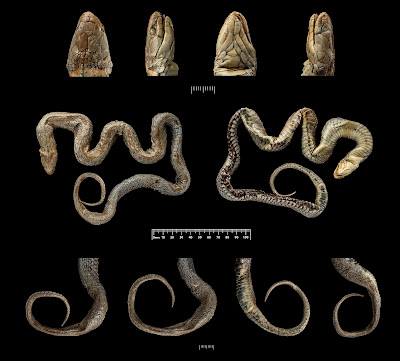 |
| Rhabdophis leonardi (Wall, 1923) in Yang, Savitzky, Gower, Deepak, Mori, ... et Zhu, 2023. (photos by S. Yang, G. Zhu, W. Tang, Xu from Huangcao Village & L. Ding) |
Abstract
The original description of Natrix leonardi (currently Rhabdophis leonardi) by Frank Wall in 1923, based on a specimen from the “Upper Burma Hills,” lacked important morphological details that have complicated the assignment of recently collected material. Furthermore, although the holotype was never lost, its location has been misreported in one important taxonomic reference, leading to further confusion. We report the correct repository of the holotype (Natural History Museum, London), together with its current catalog number. We also describe key features of that specimen that were omitted from the original description, and provide new details on the morphology of the species, including sexual dichromatism unusual for the genus, based upon specimens from southern Sichuan, China. Rhabdophis leonardi is distinguished from its congeners by the following characters: 15 or 17 DSR at midbody and 6 supralabials; distinct annulus around the neck, broad and red in males, and narrow and orange with a black border in females; dorsal ground color light green or olive; some lateral and dorsal scales possessing black edges, the frequency of black edges gradually increasing from anterior to posterior, forming irregular and ill-defined transverse black bands; eye with prominent green iris; black ventral spots with a red edge, most numerous at midbody but extending halfway down the length of the tail. In southwestern China, this species is frequently found at 1730–2230 m elevation. It has been documented to prey upon anuran amphibians, including toads. A recently published phylogenetic analysis showed this species to be deeply nested with the genus Rhabdophis, as a member of the R. nuchalis Group. That analysis also revealed the existence of two closely related but geographically distinct subclades in the molecular analysis, one of which may represent an unnamed taxon.
Keywords: distribution, morphology, Natricidae, Sinlum Kaba, snakes, systematics
Shi-Jun Yang, Alan H. Savitzky, David J. Gower, V. Deepak, Akira Mori, Rahul Khot, Jing-Song Shi, Li Ding, Mian Hou, Hai-Yuan Xu, Qin Wang and Guang-Xiang Zhu. 2023. Identity of the Holotype and Type Locality of Rhabdophis leonardi (Wall, 1923) (Colubridae: Natricinae), with notes on the morphology and natural history of the species in southwestern China. Ecology and Evolution. DOI: doi.org/10.1002/ece3.10032



